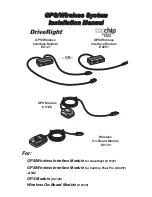
1.10 Noise, Vibration and Abnormal
Sound
1.10.1 Description and Operation
1.10.1.1
Diagnostic
Information
and
Procedures
Wind Noise/Air Sound
Warning!
Refer to "Assistant Driving Warning" in "Warnings and
Notices".
Note
Warning: An assistant should drive the vehicle while the
technician checks for the location of the reported
condition. Otherwise, personal injury could result.
A test drive is needed in order to identify the location of wind
noise. In general, the wind noise includes major leaks and
minor leaks. If the repair process does not fix all the leaks, it
will only reduce wind noise, but not completely eliminate the
wind noise.
A technician must bring the following tools to help diagnose the
specific location of wind noise:
–
Stethoscope
–
Masking Tape
–
Seal
–
Marker
–
Screwdriver
A road test should be carried out as following:
–
Select a even and straight road, with a east, a south, a west
and a north exit.
–
Select a road with minimal traffic and noise in order to avoid
affecting the test.
–
Test the vehicle at the speed when the noise is most
obviously heard. Do not speed above speed limit.
–
The noise can be identified as external wind noise, under
the following conditions,:
•
As soon as lowering the windows of the running vehicle,
the wind noise can be heard.
•
When tapes posted on various decorative seals and
gaps, the wind noise immediately disappears.
–
Internal wind noise is caused by air escaping from the car.
The repair should take the following approaches:
•
When trying to determine the leak location, attach tapes
to the body pressure relief valve. Air pressure will be
introduced inside the vehicle, which will increase wind
noise.
•
Use stethoscope to identify the leak location.
•
Use masking tapes for temporary repair.
•
Continue the road test to confirm whether all the wind
noise has been eliminated or there are still leaks at other
parts.
•
Return to workshop after having identified all the leaks
during road test. Use specialized methods and sealing
material to carry out permanent repair.
Vibration
Most of the high-speed vibrations are due to lack of wheel
dynamic balance. If there still is vibration after balancing the
wheels, the reasons are:
–
Tire Wear
–
Rim Wear
–
Difference between tires toughness
Measuring the amount of free jumping of tires and wheels can
not determine all the reasons leading to vibration. The above
mentioned three reasons are known as the radial load. You
must use known good tires and wheels to replace the old ones
and carry out the repair.
The low-speed vibration occurred at the speed of 64 km/h is
usually caused by free jumping. The high-speed vibration
occurring at the speed higher than 64 km/h is usually caused
by imbalances or free jumping.
Correct Uneven tires
There are usually two ways to correct the wheels with right
balance but still with tire vibration. One way is to use automatic
machine tools. Install the tire onto a tire machine. Grind a small
amount of rubber off from the high point of the tire. This method
is permanent. If following the operation instructions, it will not
affect the tire appearance and tire tread life. Correction using
a blade is not recommended, since this method will shorten the
tire life and can not fundamentally solve the issue.
Another method is to remove the tire and turn the tire 180 ° on
the rim. Use this method only after tire and wheel assembly
have been confirmed as the cause of vibration. This is because
this method may result vibration with good tires.
1-66
Noise, Vibration and Abnormal Sound
Vehicle Overview
EC718/EC718RV EC715/EC715RV 10/2009
Summary of Contents for EC715 2009
Page 4: ......
Page 330: ...Next Step 10 End 2 248 Fuel System JL4G18 D Engine EC718 EC718RV EC715 EC715RV 10 2009 ...
Page 1164: ......
Page 2008: ......
















































